Chinese Name: 色拉寺 Pronunciation: sè lā sì
Building Time: 1419
Opening Hours: 9:00-16:00
Suggested Visiting Hours: 2 Hours
Best Visiting Season: All seasons
Occupied Area: 114,946 square meters
Address: No. 1, Sera Road, Chengguan District, Lhasa
Building Function: It provides elderly monks with a guarantee for their livelihood and young monks with opportunities to read, write and study.
| Tickets | Peak Season (April 21st - October 19th) |
Low Season (October 20th - April 20th) |
| Admission Fee | 50 yuan | 25 yuan |
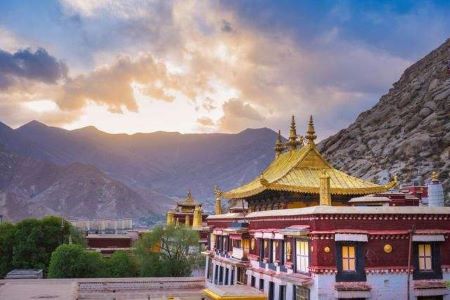
The full name of the Sera Monastery is “the Sera Mahayana Temple”, one of the six main temples in the Gelug Sect of Tibetan Buddhism. It is one of three major monasteries in Lhasa. The other two famous monasteries are Drepung Monastery and Gandan Monastery. Sera Monastery is the latest one of the three major monasteries. It has been announced as the national historical relics protection unit.
Sera Monastery was established by Jamchen Choje Shakya Yesh who was a disciple of Tsongkhapa in 1949. Located in the northern suburb of Lhasa City, Sera Monastery covers an area of 114,964 square meters. It is the second biggest monastery in Tibet. There are many small temples around it, such as Puebla Sleep Temple, Michongenicus Temple and so on.
Sera Monastery has an Assembly Hall, three colleges (Je College, Me College and Ngagpa College) and thirty-three Kamcuns. Colleges are the places for the monks to study the Buddhist Classics. Kamcuns are the dormitories in which the monks have meals and sleep. The debates of Monks here employ a style that is distinctive from those at Lhasa’s famous monasteries. Sera Monastery is also home to the first Tibetan Tripitaka printed in block engravings.
Sera Monastery was named for two hypotheses. One was that Wutse Hill was covered with wild roses before the temple was built. And the wild rose means “sera” in the Tibetan language. The other was that there was a huge hailstorm during the foundation of the temple, and the pronunciation of the hailstorm is the “sera” in the Tibetan language.

Before the construction of Sera Monastery, Tsongkhapa expounded the texts of Buddhism in a small monastery on the eastern hillside of Sera Monastery. He noted that a temple would be constructed to promote the Medium Thoughts (a religious theory) and ordered his student Jamchen Choje Shakya Yesh to build the temple.
In 1419, Jamchen Choje Shakya Yesh built Sera Monastery with the help of the leader of the Newozong, Namkhasambu.
In the 47 years since the foundation of Sera Monastery, four colleges (Jia College, Zhong Ding College, Dui Ba College and Mai Ba College) have been constructed. Each college had a lecturer, which made the Sera Monastery a great development.
In 1466, Jia College and Zhong Ding College were included in the Qie Ba College. In the 240 years since then, there have been only Qie Ba College, Mai Ba College, and Dui Ba College at Sera Monastery.
In 1705, because the old main hall of Sera Monastery was flooded, then most of the statues, scriptures and pagodas in the old main hall were moved into the new hall and the old hall turned into the Ngagpa College.
Between 1717 and 1722, Ngagpa College was restored. From then on, monks can practice tantric rituals there.
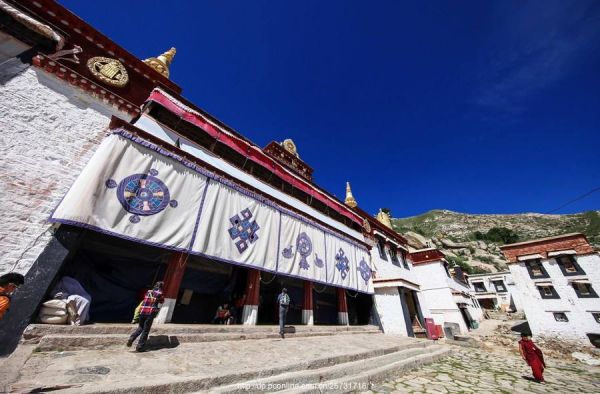
Great Assembly Hall is the largest hall and the administrative center of religious affairs at Sera Monastery. It was built in 1710 under the direct patronage of Lazang Khan, the descendant of Gushi Khan (1582-1654) who ruled from 1705 to 1717. Located in the northeast of Sera Monastery, the Assembly Hall consists of a square in front of the hall, a sutra hall, and five Lakans (Halls of Buddhism).
The square in front of the hall is covered with stones, covering an area of about 2000 square meters. The front door of the sutra hall faces the south, and outside the door is the front gallery with double rows of 10 columns, whose walls are painted with images of the Four Heavenly Kings. The sutra hall is like a forest with 89 long columns and 36 short columns, covering an area of nearly 2000 square meters. A long column rises from the center of the sutra hall to provide light.
There are three Buddha halls at the back of the sutra hall. The Jampa Temple is in the middle, with Great Window Hall on the east and Arhat Hall on the west. In the Jampa Temple, the main statue of the Great Assembly Hall, there worships the Jampa Buddha. It is tall (about 6 meters) with the body on the first floor and the head on the second floor.
On both sides of the Qiangpa Buddha statue, there are two colored statues of the Eight Great Bodhisattvas (also known as the "Eight Great Followers of the Buddha", namely Manjushri, Maitreya, Guanyin, Samantabhadra, Dashi, Void Bodhisattva, Ksitigarbha Bodhisattva, Obstacle Bodhisattva) and two Statue of Wrath God.
The Arhat Hall, in the middle of the Hall, the statue of Sakyamuni is worshiped. On both sides are statues of 16 Arhats and the Four Heavenly Kings, all painted with clay sculpture. The lord of the Great Weed Hall offers eleven-faced Vajra bullhead statues, in addition to the statues of the gods such as Yizheng, Bairam (auspicious goddess), Langse Duowen Tianwang, etc.
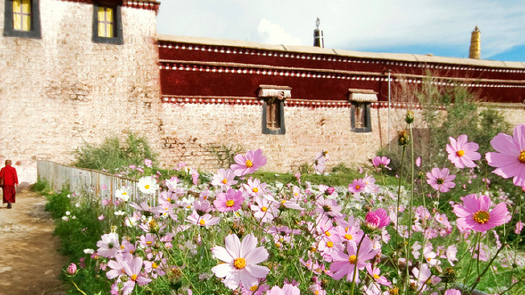
Je College is the largest college in Sera Monastery, with an area of 1702 square meters, second only to Great Assembly Hall. Je College is a four-storey college, with 100 pillars in the sutra hall alone.
Thangkas, umbrella covers, and curtains are hung in the sutra hall, and the biographies of Sakyamuni and various statues of guardians are painted on the surrounding walls.
There are two Buddhist temples on the second floor of Je College. On the west side is the Face Hall, which worships and enshrines the face of Je College’s protector, Matou Vajra. On the east side is the Guanyin Hall, in which the statue of Guan-yin Bodhisattva is located.
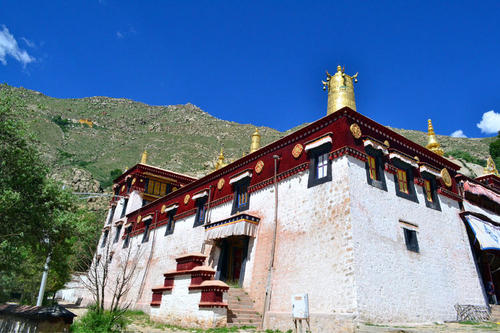
Me College is an early building of Sera Monastery, covering an area of 1620 square meters. There are 8 long columns and 62 short columns in the sutra hall. The sutra hall enshrines and worships the bronze statues of the Sabian Muni, the Future Buddha, the Buddha of immeasurable life, and the Buddha of Medicine on both sides.
There are the Temple of the Sun and the Ganjur Sutra Hall on the second floor of the Me College.

Ngagpa College is an early building of Sera Monastery, and it is also the Tantra College of Sera Monastery. It covers an area of 1517 square meters. It is three stories high and consists of a sutra hall and 4 Buddhist halls.
The sutra hall has 4 long pillars and 42 short pillars. It offers statues of Sakyamuni, Ruojian Village Sangbu, Tsongkhapa Master, Disciples, the 13th Dalai Lama on both sides. Murals are painted all over the walls of the sutra hall, with themes such as the biography of Shakyamuni, and the Dense King Kong.
Debating Scriptures originated in ancient India. In 782 AD, the King of Tubo Kingdom (ancient Tibet), Trisong Detsen ordered the Han monk Mokeyan and the Indian monk Padmasambhava to debate the epiphany and the gradual realization at Samye Monastery. It was called the “Lhasa Controversy in the history, which created a precedent for the Tibetan Buddhist debate. Since then, fierce debates have echoed in the Qinghai-Tibet Plateau for more than 1,200 years.
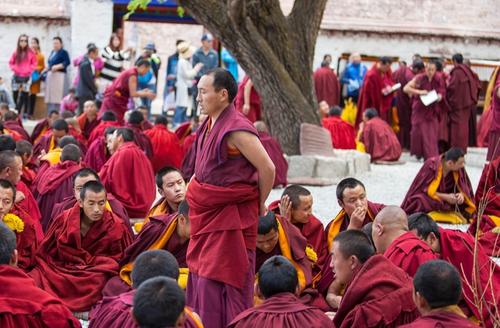
Debating Scriptures is a compulsory course in Tibetan Buddhism, and the debating test system is a method for Tibetan Buddhist monasteries to educate and study the scriptures, assess the results, and promote degrees. Only through the debating can monks be qualified to participate in the traditional summoning ceremony of the Jokhang Temple in Lhasa, and then to obtain the highest degree in Buddhism — Geshe (Geshe is a degree title of the Gelug Sect of Tibetan Buddhism, similar to the Doctor Degree in universities), to become an eminent monk. If not being a master of debating scriptures, the monk will miss the senior position in the monastery.
Debating Scriptures is a major feature of Sera Monastery. In the shade of a tree, a group of monks in red robes use all kinds of exaggerated gestures and rich body movements, sometimes waving their rosaries, sometimes glaring at each other, to express themselves, and their words are very intense. You may think it is a quarrel at first glance. In fact, this is a debate on the scriptures, a unique way of learning by Tibetan Buddhist monks. Through intense questions and debates, they test each other’s learning achievements.
Sera Monastery is one of the six main monasteries of the Gelug Sect of Tibetan Buddhism. The Debating Scriptures at Sera Monastery have a history of 600 years. In Tibet, many temples have Debating Scriptures, but the Debating Scriptures of Sera Monastery is more distinctive in terms of scale, scenes and rigorousness. Therefore, it is the most famous and has become a must-see for tourists in Lhasa.
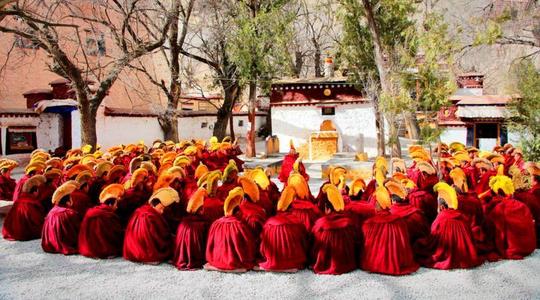
In Sera Monastery, except on Sundays, the debating can be seen every day from 3 to 5 o’clock in the afternoon, and the monks debate what they have learned in that morning. The Debating Garden of the Sera Monastery is at the north end of the passage leading to the main gate. At 3 pm, a large number of monks in red robes file in. After the brief opening ceremony, dozens of monks are divided into different groups; there are one-to-one groups and also one-to-many groups. Monks who stand ask questions, and those who answer sit on the ground. In the process of Debating Scriptures, both sides speak fiercely.
The most interesting part of Debating Scriptures is to watch the monks’ dancing movements as well as their excited and changeable expressions. The questioner usually uses a variety of gestures to increase the intensity of the debating, glaring at others, standing with one foot, clapping hands vigorously, with a strong voice to urge the other party to answer the question as soon as possible. The respondent must refute or answer without thinking. According to the rules, the respondent can only answer the questions with “Yes”, “No” or “Not certain”. If the questioner asks the respondent to explain in-depth, the respondent can state in detail; if the respondent cannot accurately answer the content learned in the morning, he should use the evening time to study again until he learns it by heart.
Lord Hayagriva is also called Horse Head King Kong (Matou Jingang) and Horse Head Avalokitesvara (Matou Guanyin). It is called “Danzhen” in Tibetan. The important sign of the Lord Hayagriva is that the head of a small horse is looking up and howling.
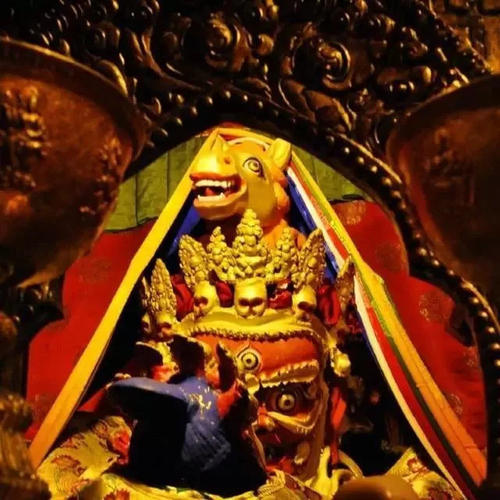
Lord Hayagriva is the incarnation of the wrath-phase of Avalokitesvara (Guanyin). His body is red, and there is a small horse head on top of his head, which can make all demons surrendered. When Master Gongqin Luozhu Sengge passed by soon after the completion of Sera Monastery, his robe was caught in the bushes several times. Later, he saw red birds flying and hiding into the bushes. The neigh of the horse was heard from the bushes. With this auspicious sign, Master Gongqin Luozhu Sengge built this statue of the Lord Hayagriva based at the bushes, then built a temple around this statue, and founded the Sera Je College. Since then, Sera Je College has developed into a large-scale monastery, where countless monks have been trained throughout the ages, and this statue of the Lord Hayagriva has also become a well-known spiritual icon in Tibet.
The statue of Lord Hayagriva is in the Shrine Hall of the Sera Je College. In front of the statue of Lord Hayagriva, the pilgrims stooped into a small hole under the altar and and prayed devoutly. They can also offer Hada (a piece of silk used as a greeting gift) here. A small amount of five-color Vajra Knots are hung beside the Buddhist altar, which are the amulets blessed by this temple. They can be purchased and hung in the doors and windows of the home or in the car for safety.
In addition, it is common that Tibetan children have black marks on their noses, and many tourists will mistake them for birthmarks. In fact, this is a mark made by the temple slightly touching the tip of the child’s nose with the ashes of the lamp in front of the icon. In Lhasa, there is a custom that not long after the baby is born, the parents will take his or her to the Jokhang Temple to worship, and then come to the Sera Temple to pray for blessings by touching the baby’s nose with the ashes of the lamp in front of the statue of Lord Hayagriva.
Take bus 6, 16, 20, 22, 23, or 24 and get off at Sela Si Temple(Sera Monastery).
Chinese: 请带我去色拉寺。English: Please take me to the Sera Monastery.
If you go to the Sera Monastery by taxi from city center, it takes about 15 yuan. However, you can bargain with the taxi driver.
